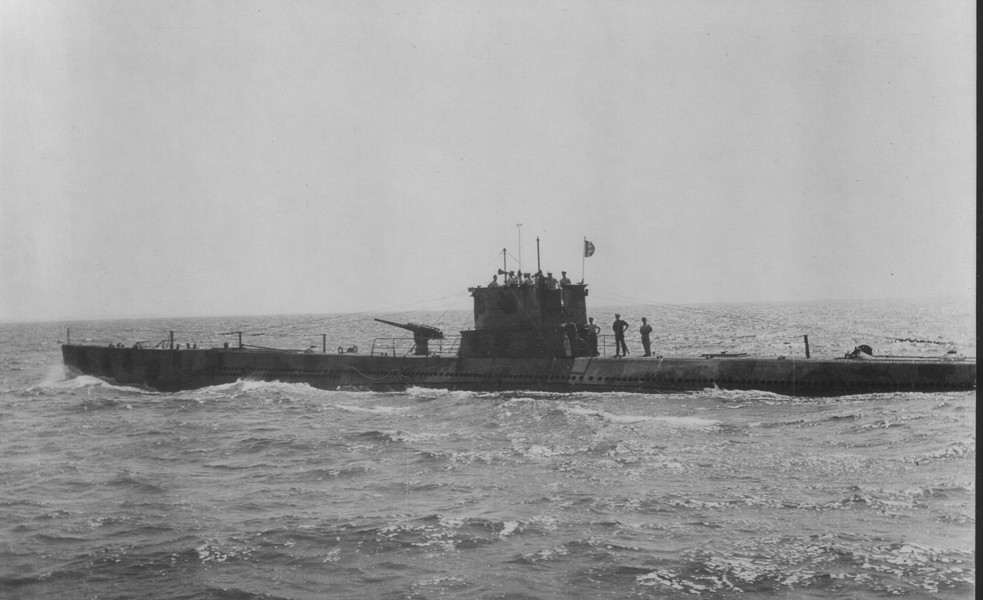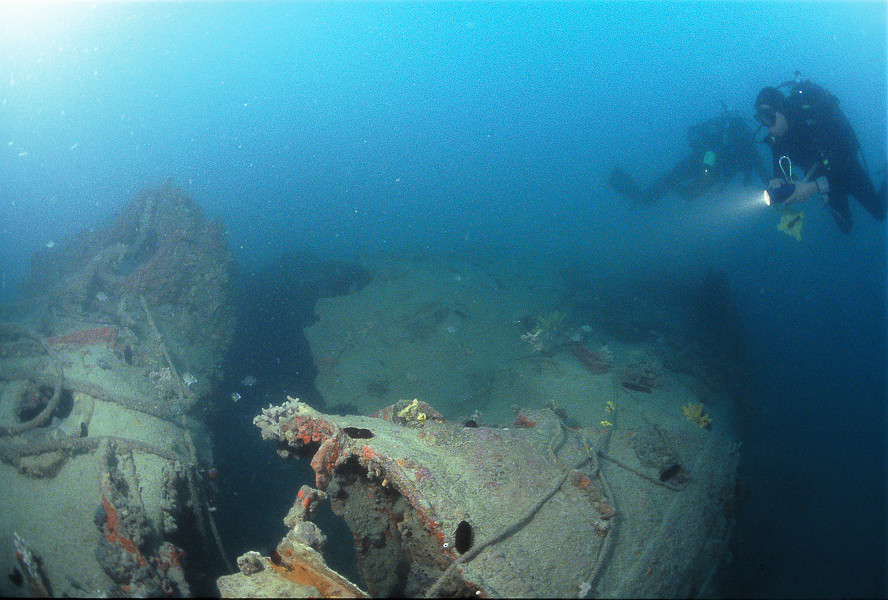
THE SUBMARINE MEDUSA
DEPTH: 36 - 38 m
SKILL: Advanced
Medusa (Argonaut class); submarine; Italy
Built: Launched 10th December 1931, C.R.D.A Monfalcone. Entered service 25th September 1932
Sunk: 30th January 1942 (torpedoed by the British submarine Thorn)
Dimensions: l=61.5 m, w=5.65 m
Coordinates: 44.84963° N, 13.80465° E
Location: near the Cape of Kamenjak, Istria. Removed, sunk again near Veruda, Pula
Access: 1/5 access is possible only by boat
Visibility: 2/5 poor, only occasionally good
Current: 4/5 mostly weak
Flora and fauna: 2/5 uniform life on and around the wreck
HISTORY:
The Medusa, a submarine of the Argonaut class, was launched into the sea on 10th December 1931 in the Italian shipyard C.R.D.A. in Monfalcone. It entered service into the navy on 25th September 1932.
From the spring of 1941 the Medusa performed navigation as part of the flotilla of the Submarine School in Pula. In the morning of 30th January 1942 the submarine sailed out on one more educational voyage towards the Bay of Kvarner. Besides the crew, also on board were 6 instructors and 21 Submarine School cadets. Around noon, when the Medusa found itself in Kvarner, near to the Cape of Kamenjak, the British submarine the Thorn, which had already resided in the Adriatic for some time, sailed by. At about 1430 hrs. the commander of the Thorn noticed the Italian submarine, on its return from Kvarner as it sailing back along the coast towards Pula, through his periscope. Placing itself into a position to attack, the Thorn fired a range of 4 torpedoes. On the tower of the Medusa at that moment there were 8 people. They spotted the wakes of the torpedoes, but it was too late. Three of the torpedoes missed, but the fourth hit the Medusa roughly in the centre. The terrible explosion threw everyone on the tower into the air, and then fell into the sea. The submarine sank immediately. On the surface only four people were left swimming alive, three of whom were injured, amongst them Commander Enrico Bertarelli. He, although injured himself, held another injured man at the surface until a boat arrived which was nearby. Despite the efforts of the rescuers, Commander Bertarelli and one sailor died, whilst the other two were saved.
In Pula the rescue operation was launched. From the port sailed fast dinghies, the torpedo boats Insidioso, Audace, Calatafimi and T3 and the submarines Mameli and Otaria, so as to arrive as soon as possible at the scene of the incident. Divers examined the hull of the submarine and established that it was almost broken in two at the level of the tower. From the interior of the stern section of the hull came the clangs of metal objects, and Morse code signals from inside conveyed the message that 14 survivors were trapped in the hull. All attempts unfortunately did not bare fruit because the submarine could not be raised to the surface in time. The unfortunate submariners, amongst them young cadets, suffocated before a crane managed to raise this part of the hull to the surface.
WRECK CONDITION AND DIVING:
Submarine wrecks are very rare in the Adriatic, and of those whose precise locations are known there are almost none. It should be noted that a possibility existed that it was not the Medusa, since some of the German submarines from the First World War had been sunk by their own crews after the capitulation of 1st November 1918. Until a detailed underwater investigation could prove its real identity, this wreck would hide its secret.
Due to poor visibility, it is only when we pass a depth of about thirty metres does the dark overgrown hull emerge from the semidarkness. Descending straight down to it, despite the poor visibility of just 4-5 metres, the rounded hull of the submarine can be recognised. It is partially smooth, and in places it is overgrown with yellow and orange sponges. Swimming along the hull we come across the point where it is split open. The panelling is torn, and in the dark interior various pipes, equipment parts and partitions can be discerned. Passing around the other side of the hull we come across thick steel cables with loops at the end which were pulled under the hull as though someone had tried to raise the hull to the surface. In the lower section of the hull we notice two diesel engines, the valve shafts and “seesaws” of which are still well-preserved. Between the engines there carefully peek large lobsters, and in the pipes near the hull there hides a large conger eel.
At the point where the hull is in cross section the distinctive construction of the submarine can be seen, with its completely circular interior - the so-called “dry” hull and the exterior so-called “wet” hull, which has a much larger diameter. In the dry hull were placed the control gear, the engine room, the communications department and crew’s quarters, whilst in the external (wet) hull were placed the ballast tanks and other equipment. On the upper section of the hull is obliquely placed a circular opening which is missing its cover. This was the opening for loading torpedoes into the stern area. In the confined spaces of the submarine the torpedoes were immediately loaded into the torpedo tubes, whilst the standby torpedoes usually hung above the beds of the crew. The part of the hull which we have examined is the area of the engine room, about 22 metres long, and since the whole length of the submarine was about 60 metres, it means that the other part or parts of the submarine lie somewhere else. We searched the wider area around the submarine, but we did not find any other trace.
The description and illustrations are a courtesy of Danijel Frka and Jasen Mesić. Buy the whole book here: https://shop.naklada-val.hr/product_info.php?products_id=561
Built: Launched 10th December 1931, C.R.D.A Monfalcone. Entered service 25th September 1932
Sunk: 30th January 1942 (torpedoed by the British submarine Thorn)
Dimensions: l=61.5 m, w=5.65 m
Coordinates: 44.84963° N, 13.80465° E
Location: near the Cape of Kamenjak, Istria. Removed, sunk again near Veruda, Pula
Access: 1/5 access is possible only by boat
Visibility: 2/5 poor, only occasionally good
Current: 4/5 mostly weak
Flora and fauna: 2/5 uniform life on and around the wreck
HISTORY:
The Medusa, a submarine of the Argonaut class, was launched into the sea on 10th December 1931 in the Italian shipyard C.R.D.A. in Monfalcone. It entered service into the navy on 25th September 1932.
From the spring of 1941 the Medusa performed navigation as part of the flotilla of the Submarine School in Pula. In the morning of 30th January 1942 the submarine sailed out on one more educational voyage towards the Bay of Kvarner. Besides the crew, also on board were 6 instructors and 21 Submarine School cadets. Around noon, when the Medusa found itself in Kvarner, near to the Cape of Kamenjak, the British submarine the Thorn, which had already resided in the Adriatic for some time, sailed by. At about 1430 hrs. the commander of the Thorn noticed the Italian submarine, on its return from Kvarner as it sailing back along the coast towards Pula, through his periscope. Placing itself into a position to attack, the Thorn fired a range of 4 torpedoes. On the tower of the Medusa at that moment there were 8 people. They spotted the wakes of the torpedoes, but it was too late. Three of the torpedoes missed, but the fourth hit the Medusa roughly in the centre. The terrible explosion threw everyone on the tower into the air, and then fell into the sea. The submarine sank immediately. On the surface only four people were left swimming alive, three of whom were injured, amongst them Commander Enrico Bertarelli. He, although injured himself, held another injured man at the surface until a boat arrived which was nearby. Despite the efforts of the rescuers, Commander Bertarelli and one sailor died, whilst the other two were saved.
In Pula the rescue operation was launched. From the port sailed fast dinghies, the torpedo boats Insidioso, Audace, Calatafimi and T3 and the submarines Mameli and Otaria, so as to arrive as soon as possible at the scene of the incident. Divers examined the hull of the submarine and established that it was almost broken in two at the level of the tower. From the interior of the stern section of the hull came the clangs of metal objects, and Morse code signals from inside conveyed the message that 14 survivors were trapped in the hull. All attempts unfortunately did not bare fruit because the submarine could not be raised to the surface in time. The unfortunate submariners, amongst them young cadets, suffocated before a crane managed to raise this part of the hull to the surface.
WRECK CONDITION AND DIVING:
Submarine wrecks are very rare in the Adriatic, and of those whose precise locations are known there are almost none. It should be noted that a possibility existed that it was not the Medusa, since some of the German submarines from the First World War had been sunk by their own crews after the capitulation of 1st November 1918. Until a detailed underwater investigation could prove its real identity, this wreck would hide its secret.
Due to poor visibility, it is only when we pass a depth of about thirty metres does the dark overgrown hull emerge from the semidarkness. Descending straight down to it, despite the poor visibility of just 4-5 metres, the rounded hull of the submarine can be recognised. It is partially smooth, and in places it is overgrown with yellow and orange sponges. Swimming along the hull we come across the point where it is split open. The panelling is torn, and in the dark interior various pipes, equipment parts and partitions can be discerned. Passing around the other side of the hull we come across thick steel cables with loops at the end which were pulled under the hull as though someone had tried to raise the hull to the surface. In the lower section of the hull we notice two diesel engines, the valve shafts and “seesaws” of which are still well-preserved. Between the engines there carefully peek large lobsters, and in the pipes near the hull there hides a large conger eel.
At the point where the hull is in cross section the distinctive construction of the submarine can be seen, with its completely circular interior - the so-called “dry” hull and the exterior so-called “wet” hull, which has a much larger diameter. In the dry hull were placed the control gear, the engine room, the communications department and crew’s quarters, whilst in the external (wet) hull were placed the ballast tanks and other equipment. On the upper section of the hull is obliquely placed a circular opening which is missing its cover. This was the opening for loading torpedoes into the stern area. In the confined spaces of the submarine the torpedoes were immediately loaded into the torpedo tubes, whilst the standby torpedoes usually hung above the beds of the crew. The part of the hull which we have examined is the area of the engine room, about 22 metres long, and since the whole length of the submarine was about 60 metres, it means that the other part or parts of the submarine lie somewhere else. We searched the wider area around the submarine, but we did not find any other trace.
The description and illustrations are a courtesy of Danijel Frka and Jasen Mesić. Buy the whole book here: https://shop.naklada-val.hr/product_info.php?products_id=561








 The investment is co-financed by the Republic of Slovenia and the European Union from the European Regional Development Fund.
The investment is co-financed by the Republic of Slovenia and the European Union from the European Regional Development Fund.  H2O Globe BETA
H2O Globe BETA